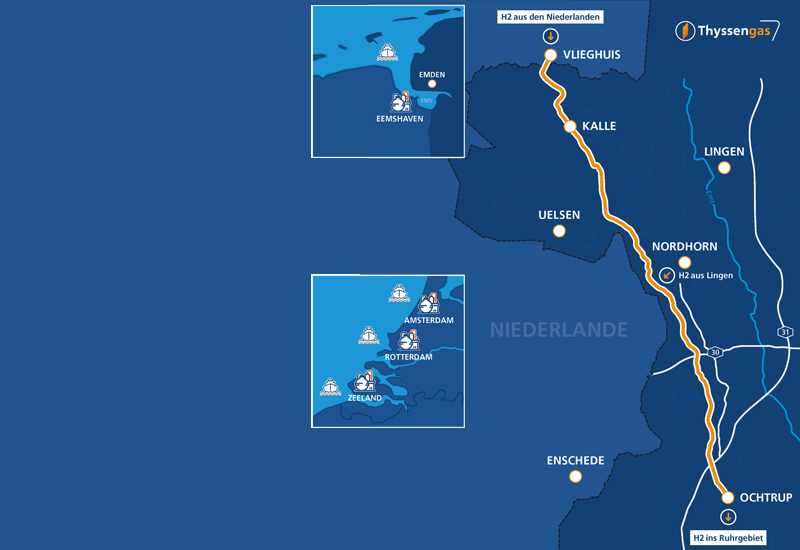The Netherlands/Germany – A natural gas pipeline with a length of around twelve kilometers has been purchased by Thyssengas GmbH from RWE Generation SE. In the Netherlands, this connects Kalle in the municipality of Hoogstede with Vlieghuis in the municipality of Coevorden (county of Bentheim).
The link is crucial to the establishment of a transnational hydrogen transportation network. Thyssengas’ ambitions to link to the Vlieghuis import point as part of the GET H2 hydrogen initiative are what led to the purchase. From 2027, the operator of the Dortmund long-distance network hopes to make it possible for hydrogen to be transported from the Dutch border to Duisburg-Hamborn. This marks the start of a new phase in the transportation of hydrogen across borders between Germany and the Netherlands.
The connection provides access to the province of Zeeland, the import ports of Amsterdam, Eemshaven, and Rotterdam, as well as the storage facilities and future hydrogen production facilities there, on the one hand. The Dutch government also plans to develop sizable offshore hydrogen producing capacities in the upcoming years. Direct hydrogen synthesis occurs at sea from the energy produced in the wind farms off the coast of the North Sea. For the quick expansion of the hydrogen market in Germany, an import connection to these H2 amounts is crucial.
Infrastructure for cross-border transportation
The Thyssengas project is the cornerstone for the creation of an international H2 infrastructure, together with other hydrogen-related projects. The production, transport, storage, and industrial use of green hydrogen are to be connected in a series of steps between 2024 and 2027 as part of the broader GET H2 project from Lingen (Emsland) to the Ruhr region and from the Dutch border to Salzgitter. The connection of Salzgitter’s steel production will result in the completion of the H2 system in 2030.
The GET-H2 partners bp, Evonik, Nowega, OGE, and RWE Generation intend to link the production of green hydrogen with industrial customers in Lower Saxony and North Rhine-Westphalia through the “GET H2 Nucleus” as the first step. The following stage of growth is the Vlieghuis-Kalle line connection by Thyssengas to the Netherlands. It establishes the framework for a trans-European market for hydrogen.
The long-distance gas network operators OGE and Nowega’s current network as well as the new hydrogen line that will be constructed from Dorsten to Duisburg-Hamborn will subsequently be used to transport the hydrogen to the Ruhr region. This pipeline is being built by the two long-distance gas network providers OGE and Thyssengas. The project should be finished in 2026.
IPCEI financing request
Preparatory conversion steps are already scheduled to begin in the middle of 2023 in order to convert the Vlieghuis-Kalle gas pipeline and its additional route to Ochtrup (which is already a part of the Thyssengas network) to transport 100% hydrogen. Thyssengas has prepared a number of inspection and maintenance procedures on the line section in order to achieve this. A grant request for the IPCEI program includes the project.
GET H2 has Thyssengas as a finance partner. In order to facilitate the effective execution of the energy transition, the program seeks to establish a national hydrogen infrastructure. About 50 businesses, organizations, and towns are actively supporting GET H2 and are dedicated to developing a competitive hydrogen market and making the required changes to the legislative and regulatory framework.





